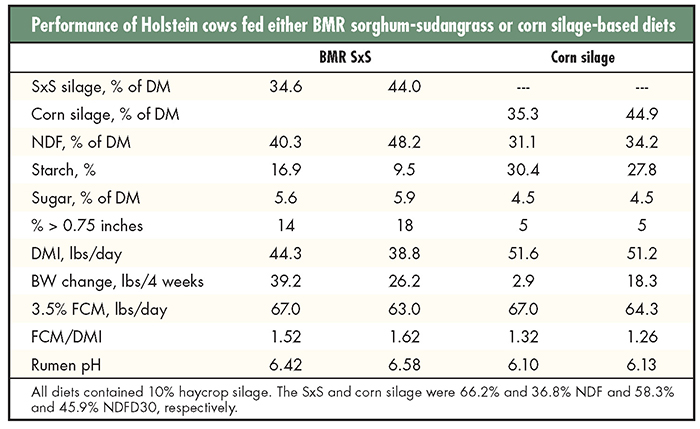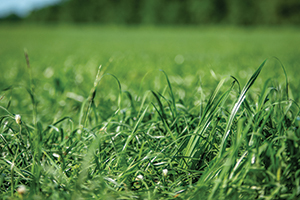
Historically, dairy rations have utilized corn silage and alfalfa as the primary forage components. While farms have had a lot of success feeding these forages, growing environmental pressure, competition for land, and the need to grow more digestible fiber per acre has pushed many progressive dairies to “alternative” forage options.
On our clients’ farms, we have begun utilizing a variety of alternative forages with the goal of having the highest neutral detergent fiber digestibility (NDFD30) and the lowest indigestibility (uNDF240) while also producing the highest yield of both tons of forage and digestible fiber (dNDF30) per acre. Often, our client dairies are producing up to twice the yield of digestible NDF per acre with these forages compared to more conventional rotations.
The forage systems we design need to provide adequate acres for nutrient application every month of the forage harvesting season to remove application pressure in the spring and fall. Alternative forages help us create those application windows.
Many options available
A list of forages we commonly recommend for high-producing dairies are composed of perennial, European cool-season grasses, especially meadow fescue, tall fescue, and festulolium; legumes, especially red clovers and vetches; brown midrib (BMR) warm-season annuals such as sorghum-sudangrass, sudangrass, and millet; winter small grains such as triticale, and when it gets too late for planting triticale, cereal rye. We have also started using a lot of Italian and annual ryegrass, either mixed with warm-season annuals in the North or with winter small grains. Specific varieties of these crops are chosen for yield, high digestibility, and low indigestibility.
Rarely do we recommend these crops as monocultures. We look for combinations that work well together and fit the ambient climate for the dairy or livestock operation in question. The forages we recommend will depend somewhat on the area of the country, but many times it is just that the combination of cultivars and species (cocktail mixes) are more different in their timing. Obviously, for example, warm-season annuals can be planted much earlier in the spring in Texas than in northern Wisconsin or Upper Michigan.
To discover which varieties work well together, extensive plots have been established over the last 15 years at our research locations. On the Olson Farm, we have planted plots in a crisscrossing pattern. Each tested legume may be planted in a north-south direction and various grasses are planted east-west, creating a grid of hundreds of combinations. Each grass and each legume have two or more patches for observation. Often the plants that work well together are ones with different top- and bottom-growth characteristics, so we are able to best use all the resources nature gives us.
Notice that alfalfa is not on our list. There are some areas where alfalfa does extremely well, and those farmers may have a hard time giving it up. Still, using our three metrics of high yield, high digestibility, and low indigestibility, alfalfa does not stand up to the crops we usually recommend.
Horizontal storage preferred
Typically, these crops need to be stored horizontally. Adjustments in forage choices can be made where a tower silo must be utilized. Many of these forages will be harvested at the top of the moisture guidelines (65% moisture or more) and should be treated with homofermentative, lactic acid-producing bacterial inoculants rather than heterofermenters, which produce lactic and acetic acids. Wide-swathing will speed the dry down rate and preserve sugars. With sorghums, we will normally have an underlying forage that will provide somewhat of a carpeting effect to mitigate ash (soil) pickup.
Risk mitigation
With weather patterns becoming more erratic, we feel that in many cases cocktail mixes of various annuals will help to mitigate that risk. In the Upper Midwest and Northeast, we are combining BMR sorghum-sudangrass, Italian ryegrass, and legumes in the same mix. During a “normal” year, the sorghum-sudangrass will be dominant over the first few cuttings in July and August, and then the Italian ryegrass will come on strong in the fall as temperatures cool down. Of course, drier, hotter weather will favor the warm-season crop and cooler, wetter weather will favor the cool-season crop, so there is an element of risk mitigation even though the cocktail may look different each year.
In some areas, because of predictable weather patterns that disfavor one species or the other, the disfavored species would not be in the cocktail.

How they’re fed
Most of our dairies are still feeding corn silage at about 50% to 60% of the forage dry matter (DM). The remaining forage is made up of alternative forages. The large digestible fiber pool that these crops provide allow us to virtually eliminate straw and other fiber sources like cottonseed and by-products. The highest percentage of this feed will be digested and can greatly enhance feed efficiency.
The concept for this system stemmed from research by Rick Grant, president of the W.H. Miner Institute, which compared digestible fiber energy to starch energy. Mid-lactation cows were fed an extremely high amount of fiber from mature BMR sorghum-sudangrass (SxS) silage. That diet was compared to the same ration but with corn silage (CS) instead of the SxS. Two groups were fed either 35% of the DM of 66.2% NDF SxS or the same amount of 36.8% NDF CS. Another two groups received 45% of their DM as SxS or CS. Ten percent of the forage was haycrop silage in each diet (see table).
The SxS diets were 40.3% and 48.2% NDF and the CS diets were 31.1% and 34.2% NDF. The total starch in the diet for the SxS was allowed to drop to 16.9% and 9.5%, respectively. Consequently, and not surprisingly, the dry matter intake (DMI) dropped to 44.3 pounds and 38.8 pounds per day in the SxS diets. The DMIs and starch levels were more typical for the CS diets. Anyone would think looking at this evidence that the SxS diets were a train wreck. However, the SxS cows in both diet groups gained a pound per day during the trial, and the CS cows had very little body weight change. There was no significant difference in milk production, and the SxS produced a higher percent butterfat. Milk efficiency (fat-corrected milk/DMI) greatly improved.
Although we can’t push high-group cows to these NDF levels, the concept was intriguing. Over the last few years, we have worked with nutritionists to develop NDF and uNDF parameters and have found that we can improve feed efficiency by 5% to 10% without sacrificing production or triggering body weight loss.
Final thoughts

In our forage systems, about half of the acres are in corn silage every year. This means that every crop of silage follows a previous year’s alternative forage crop. First-year corn is the least expensive and most productive crop we can grow, and so we want to maximize those acres. By rotating aggressively with annuals, we are able to achieve that goal.
There are always places to apply manure in these flexible forage systems. You are not tied to application windows when you should be planting or harvesting crops. High-yielding grasses have a high level of phosphorus uptake and efficiently utilize the nutrients during the growing season.
By looking outside the corn-alfalfa box on every acre, progressive dairy farmers can lower ration costs and improve productivity and profitability on their farms while solving nutrient management issues and lowering risk in years when Mother Nature doesn’t cooperate.
This article appeared in the January 2021 issue of Hay & Forage Grower on pages 14 and 15.
Not a subscriber? Click to get the print magazine

